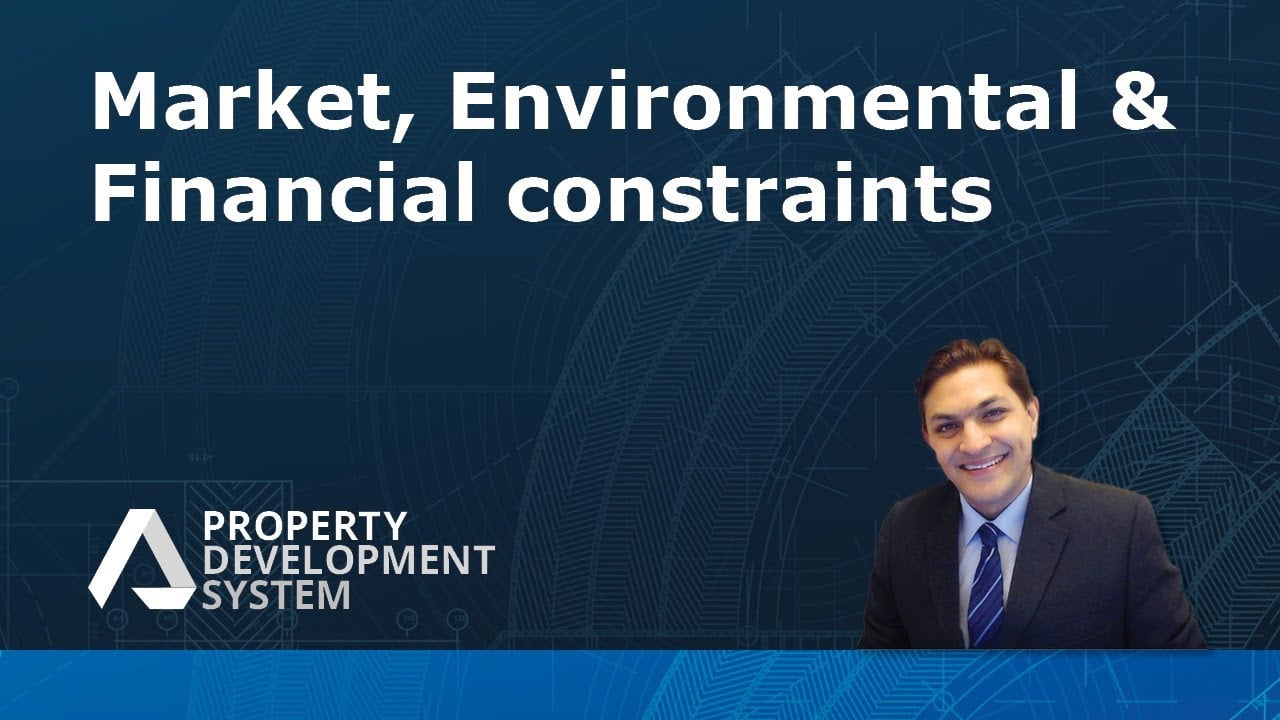Market, Environmental & Financial Constraints
Here is a comprehensive look at the critical factors influencing real estate development projects. It covers the impact of environmental conditions, the timing of market cycles, and the financial considerations necessary for the successful planning and execution of such projects.
Environmental Constraints
Focuses on the impact of weather elements on buildings, such as sun exposure, wind speeds, and flood zones. It emphasises the importance of land contamination, carbon footprint, and environmentally sustainable designs (ESD).
Market Cycles
Analyses the timing of development projects to coincide with market upturns, supply and demand, and competition. Highlights the significance of timing for retail, commercial, and accommodation developments, particularly in relation to seasonal selling periods and major events.
Financial Constraints
Describes the primary concern in development projects as financing, detailing different sources like equity finance, debt financing, and the costs associated with them. It stresses the need for a thorough financial feasibility analysis.
Insights based on numbers
- The analysis touches on several critical numerical aspects, such as the percentage of equity finance, interest rates, and the timing of market cycles in relation to seasons and events. It suggests that the success of development projects is closely tied to precise financial planning and market timing, highlighting the complexity of balancing environmental considerations with financial and market constraints.
Frequently Asked Questions
How do environmental constraints like sun exposure and wind speeds affect building design?
It mentions the importance of considering the building’s orientation to maximise or minimise sun exposure depending on the climate and how high wind speeds at elevated altitudes can affect the structural integrity and design of taller buildings.
This aspect underlines the necessity for thorough environmental studies, like wind studies and energy efficiency assessments, to ensure that the buildings are both sustainable and safe in their respective environments.
What role do market cycles play in the timing of development projects?
It stresses that understanding and aligning with market dynamics—such as supply and demand fluctuations and competing developments—are essential for maximizing the project’s success. For example, retail and commercial projects should be timed to hit the market during peak selling seasons, while hotels and accommodations should aim to open before major events, like the Olympics, to capitalise on increased demand. This strategic timing ensures that developments are well-positioned to attract buyers and tenants, leveraging seasonal and cyclical market trends to their advantage.
What are the key financial constraints in development projects, and how do they influence project feasibility?
It identifies various financing sources, including equity finance and debt financing, and underscores the necessity of accurately calculating finance costs, such as interest rates and setup fees. The video emphasises that understanding the composition of financial resources—like the proportion of equity versus debt financing—and the associated costs is crucial for conducting an accurate financial feasibility analysis. This analysis helps developers gauge the viability of a project, ensuring that they can meet financial obligations while maximising returns, thereby significantly influencing the project’s overall feasibility and success.
What are environmental constraints in real estate development?
Environmental constraints in real estate development refer to the natural and ecological factors that can impact the design, location, and sustainability of development projects. These include weather elements like sun exposure, wind speeds, and flood zones, which affect the structural integrity and functionality of buildings. Additionally, issues such as land contamination, the carbon footprint of construction activities, and the importance of incorporating environmentally sustainable designs (ESD) play a critical role. These factors necessitate careful planning and adaptation to ensure that development projects are both ecologically responsible and viable.
How do market cycles influence real estate development?
Market cycles are significant in real estate development because they affect the timing of project launches and the overall demand for real estate. Timing development projects to coincide with market upturns can lead to higher profitability and lower risks. These cycles are influenced by factors such as supply and demand, competition, and external economic conditions. For retail, commercial, and accommodation developments, aligning project completion with seasonal selling periods or major events can maximise revenue opportunities and market penetration.
Why is a thorough financial feasibility analysis important?
A thorough financial feasibility analysis is crucial in real estate development because it helps developers understand the financial implications of their projects. This analysis examines various factors, including the costs of financing, potential revenue, and market conditions. By evaluating these elements, developers can make informed decisions about proceeding with projects, securing financing, and optimizing financial structures. A well-conducted financial feasibility analysis reduces the risk of financial failure and enhances the likelihood of a project’s success.
How do environmental considerations impact financial planning and market timing in development projects?
Environmental considerations impact financial planning and market timing in development projects by adding layers of complexity to the development process. Adhering to environmentally sustainable designs and mitigating environmental constraints often require additional investments and careful planning to meet regulatory standards and achieve sustainability goals. These considerations can influence the timing of project completion, as developments may need to accommodate seasonal weather patterns or remediate land contamination. Consequently, developers must balance these environmental factors with financial constraints and market cycles to ensure project viability and success.
How can developers balance environmental, financial, and market constraints?
Balancing environmental, financial, and market constraints requires a strategic and holistic approach to real estate development. Developers can achieve this balance by:
- Conducting comprehensive environmental assessments to understand and mitigate potential impacts.
- Performing detailed financial feasibility studies to ensure projects are financially viable and identify the best financing options.
- Timing projects to align with favourable market cycles and demand forecasts.
- Incorporating flexible design principles that can adapt to changing environmental and market conditions.
- Engaging in sustainable development practices to reduce environmental impacts and appeal to a growing market for green real estate.
Test Your Knowledge
1. What aspect of environmental constraints is NOT mentioned as impacting real estate development?
A) Soil fertility for agricultural developments
B) Sun exposure affecting building design
C) Wind speeds influencing structural engineering
D) Flood zones determining construction feasibility
2. How do market cycles influence the planning of real estate development projects?
A) By dictating the architectural styles to be used
B) Through impacting the timing of project launches to align with market upturns
C) By determining the color schemes of residential developments
D) Through the preference for urban over rural development
3. Which of the following is a primary financial constraint in real estate development?
A) The choice of construction materials
B) The availability of skilled labor
C) The sources and costs of financing
D) The selection of development locations
4. Why is a financial feasibility analysis critical for real estate development projects?
A) It helps in selecting the project team members
B) It determines the environmental impact of the project
C) It assesses the project’s financial viability and risk
D) It ensures the project’s compliance with local building codes
5. Which factor is NOT directly influenced by market cycles in real estate development?
A) The success of retail developments
B) The demand for accommodation facilities
C) The colour trends in interior design
D) The supply and demand balance in the market
6. Environmental sustainable designs (ESD) in real estate development primarily focus on:
A) Reducing the overall cost of the project
B) Minimizing the impact on local wildlife
C) Lowering the carbon footprint and improving energy efficiency
D) Increasing the speed of construction
7. What is NOT a typical source of financing mentioned for real estate development projects?
A) Equity Finance
B) Debt financing
C) Cryptocurrency investments
D) Costs associated with borrowing
8. Which of the following is least likely to be considered in a financial feasibility analysis for a real estate project?
A) Interest rates on loans
B) The percentage of equity finance
C) The personal preferences of the project developer
D) The timing of market cycles in relation to project launch
Answers:
- A) Soil fertility for agricultural developments
- B) Through impacting the timing of project launches to align with market upturns
- C) The sources and costs of financing
- C) It assesses the project’s financial viability and risk
- C) The color trends in interior design
- C) Lowering the carbon footprint and improving energy efficiency
- C) Cryptocurrency investments
- C) The personal preferences of the project developer
Assignment
Real Estate Development Project Assignment
Objective:
This assignment is designed to help students apply the concepts of market, environmental, and financial constraints to a hypothetical real estate development project. Through this exercise, students will demonstrate their understanding of how these factors influence the planning, execution, and success of real estate projects.
Instructions:
You are tasked with planning a new real estate development project. Choose one of the following types for your project:
- Retail development
- Commercial office building
- Residential housing complex
- Accommodation facility (e.g., hotel or apartment building)
Part 1: Environmental Analysis
To Do:
- Choose a specific location for your project and describe the environmental constraints that may affect the development, including weather elements, flood zones, and any potential land contamination.
- Propose environmentally sustainable design (ESD) features that could mitigate these constraints.
Research Question:
- What are the local environmental regulations that could impact your development project?
Part 2: Market Analysis
To Do:
- Analyse the market cycle phase relevant to your project type and location. Determine whether the current phase is advantageous for initiating your development.
- Identify the key demand drivers for your chosen type of development in the selected location.
- Discuss how seasonal selling periods or major events could influence the success of your project.
Research Question:
- How does the competition in your chosen location and development type affect your project planning?
Part 3: Financial Analysis
To Do:
- Outline the main sources of financing you plan to use for your project (e.g., equity financing, debt financing).
- Conduct a basic financial feasibility analysis: estimate the overall cost of the project, potential revenue, and discuss the financial risks involved.
Research Question:
- What are the current interest rates for debt financing in your project’s location, and how might these affect your project’s financial feasibility?
Part 4: Integrative Strategy
To Do:
- Develop an integrated strategy that addresses how you will balance environmental considerations, market timing, and financial constraints to ensure the success of your project.
- Include a timeline that outlines the key milestones from planning to completion of the project.
Research Question:
- Identify a real-life example of a development project that successfully balanced these three constraints. What lessons can be learned from this example?
Submission Guidelines:
- Prepare a report that covers all the parts of the assignment. Your report should be between 2000 to 3000 words.
- Support your analysis with data and references where applicable. Include a bibliography of all sources used.
- Submit your report in PDF format via mail or comments.



